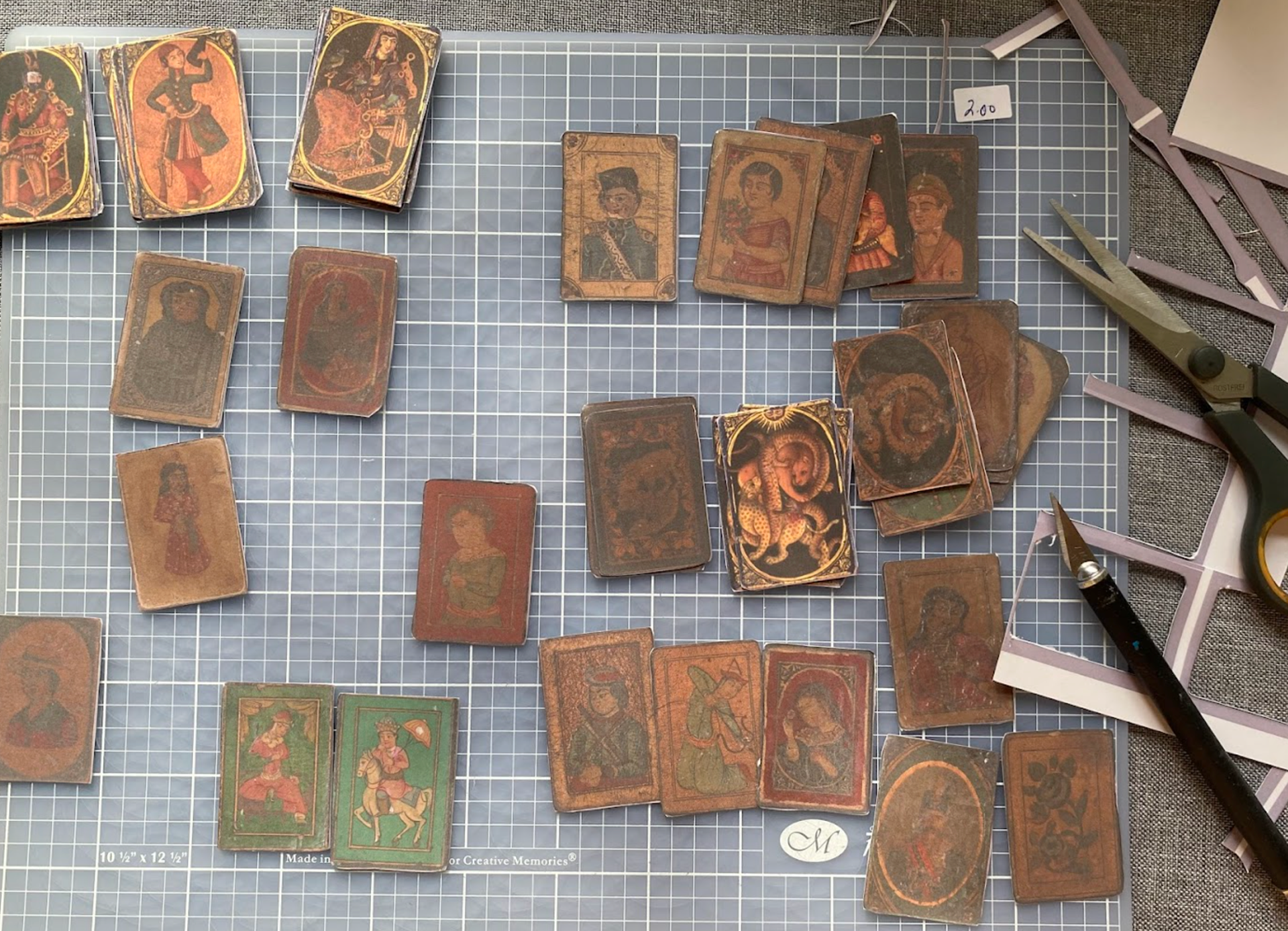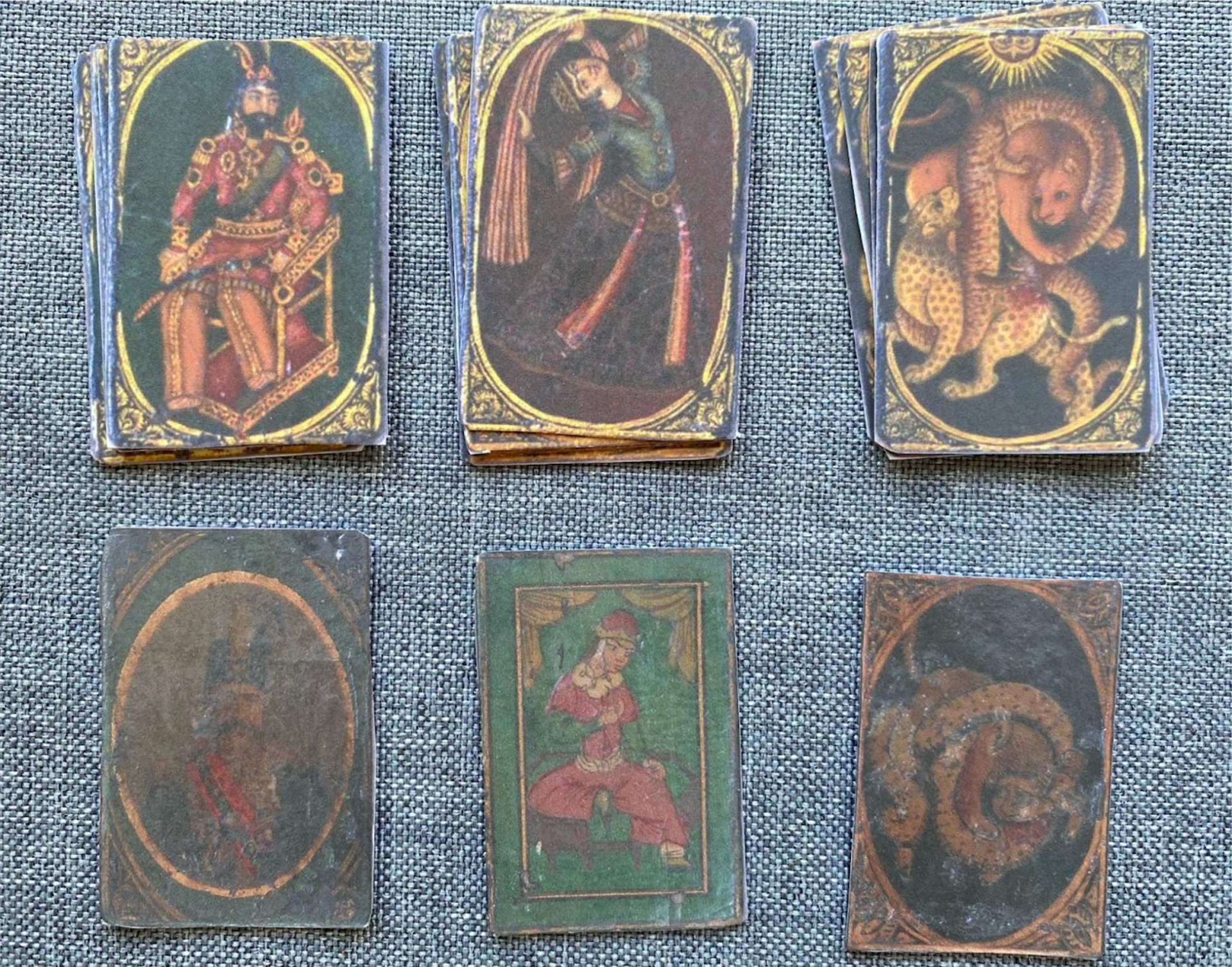CURATORIAL RESEARCH - In Dialogue with the Displaced: Artists, Images and Bodies
April - June 2025
Research sites: International Studio and Curatorial Program, Metropolitan Museum of Art, Brooklyn Museum
In a comparative study on symbols and approaches:
Ganjifa playing cards as tokens of the visual culture of 19th-century Iran
<>
Contemporary Iranian art by women artists in New York
Sponsored by: Alberta Foundation for the Arts, Behdad Esfahbod
My inquiry is into the art and artists in two revolutionary eras of Iranian history to initiate dialogue and tell the stories of displacement on individual and collective levels. With the foundation of this curatorial research, I can eventually publish a book and present an exhibition to promote multiculturalism in my home province of Alberta and bring more visibility to the Iranian heritage in North America.
Today, the Iranian diaspora is established in the United States and Canada. New York City is a hub for influential visual artists of Iranian heritage such as Shirin Neshat. This diaspora is mainly formed after the 1979 revolution that led to the Islamic Republic; a State of censorship and gender inequality. Since 2022, the global community is witnessing a revolutionary uprising called Women, Life, Freedom; a movement rooted in the demand for bodily autonomy and intersectional struggles. It is creatively manifested in a vast body of artwork produced by diaspora Iranian artists, including myself.
Late 19th century Iran paved the way for the Persian Constitutional Revolution and gave birth to the Iranian women’s movement spanning till this day. The first Iranian travellers arrived in the United States during that period of international exchange and World Fairs. Some claim that Haj Sayyah -the author of one travelogue I will study- was the first Iranian to become an American Citizen in 1875.
The playing cards, select contemporary Iranian women diaspora artists, and the travel diaries tell stories of the displacement of Iranian people and cultural artifacts. Expressions of body politics are visible in my targeted subjects and are the creative themes of my curatorial and artistic practice.
This residency will facilitate the writing of my book proposal, and allow me to organize a sample exhibition of my findings at the end of the ISCP residency program.

Mockup replicas of Ganjifa Cards held at the Metropolitan Museum of Art and Brooklyn Museum

Comparing mockup replicas of Ganjifa Cards held at the Metropolitan Museum of Art and Brooklyn Museum
Silent and Present brings together the voices of 7 artists in Alberta in response to two questions: How have you experienced moments of silence and presence? Can you depict those moments in a non-representational manner?
In a complementary collection of artworks, the artists express various ways of perceiving silence. This showcase of abstract works explores colours, shapes, lines and texture to deliver a broad spectrum of styles from expressionist to minimalistic, some of which are pushing boundaries or visual traditions.
Silence is receptive and potent towards the presence of phenomena. Each exhibiting artist has a unique process for communicating the concept. Some artists emphasize the required silence in the creation process, while others rely on their own capability to be present while staying with their work.
In a complementary collection of artworks, the artists express various ways of perceiving silence. This showcase of abstract works explores colours, shapes, lines and texture to deliver a broad spectrum of styles from expressionist to minimalistic, some of which are pushing boundaries or visual traditions.
Silence is receptive and potent towards the presence of phenomena. Each exhibiting artist has a unique process for communicating the concept. Some artists emphasize the required silence in the creation process, while others rely on their own capability to be present while staying with their work.
Silence is the absence of noise and sound. Our sentences make sense of the empty space in between the words. In a way comparable to emptiness, we fill silence with our presence, while silence opens up the space for each of us to realize our own presence. Taking a moment of silence in gatherings is a common tradition in respect to a sense of loss; the absence of life. All around the world, different faiths and spiritual and mystical schools cherish and encourage silence in ritualistic settings, and in monastic life. These days, various benefits of meditation in silence and being still are promoted by the wellness industry, through various smartphone applications or in all kinds of guided retreats. Silence is not all about tranquility, and a warm, harmonic presence. Passive silence in times of necessity for action can be destructive too. In a world challenged by ongoing global issues, we are reminded of some features that distinguish human consciousness from that of nature; two of which are communication through art and speech. Ultimately, each individual's choice and effort, or sometimes just a coincidence of internal and/or external events, leads to a universal and joyous experience of silence, emptiness and stillness.
The exhibition title refers to the interplay of two human experiences that might not always go together, and yet contribute to one another.
Inspiration for this exhibition comes from long silent meditation retreats I have participated in and gained first-hand insight into how dwelling in silence can first resurface noises and thoughts, and how we can integrate our presence with those noises and thoughts in our busy daily lives.
Silent and Present encourages a curious look into the nature of these two concepts. As a whole, the exhibition sets aside dictated definitions and freely displays various takes on the theme. This realization comes from a place of being present with one’s personal insight.
I am grateful to the Bleeding Heart Art Space team for providing the space and resources for this meaningful exhibition project. I hope when stepping out of this exhibition, the viewer’s imagination is broadened and they take away an intangible present from the artists.
Inspiration for this exhibition comes from long silent meditation retreats I have participated in and gained first-hand insight into how dwelling in silence can first resurface noises and thoughts, and how we can integrate our presence with those noises and thoughts in our busy daily lives.
Silent and Present encourages a curious look into the nature of these two concepts. As a whole, the exhibition sets aside dictated definitions and freely displays various takes on the theme. This realization comes from a place of being present with one’s personal insight.
I am grateful to the Bleeding Heart Art Space team for providing the space and resources for this meaningful exhibition project. I hope when stepping out of this exhibition, the viewer’s imagination is broadened and they take away an intangible present from the artists.
Asal Andarzipour - November 2023
Mona Sahi expresses human violence in a considerate manner; being mindful of the triggering impact of her art on her audience. In an age of being surrounded by graphic content in the news and social media, she filters out the inevitable ugliness of causing harm, without ignoring the real issues. Touching on difficult subject matters and themes, her art is genuinely brave. There is no distinction in her sensitivity to various forms of life. Mona lets her art be a reflection of a past visit to a slaughterhouse, or a reproduction of remnants of a crackdown on peaceful street protests in her home country Iran. Her work is about controlled, imprisoned, and violated bodies.
Mona Sahi’s stylistic choices in picturing human and animal bodies, and the appearance of the color red along with carefully desaturated blues and browns remind us of the works by Bahman Mohasses (1931-2010); a highly celebrated Iranian artist whose life and career continues to inspire generations despite years of censorship and physical elimination. Coming from the Gilan Province and both having grown up while breathing in the special air of the Caspian Sea, and later becoming artists in the Iranian diaspora are the shared lived experience between Mohasses and Sahi. However, Mona’s courageous compositions create a unique atmosphere in every piece. In her acrylic paintings, the brushstrokes are free-flowing. Her meticulous attention to detail stands out in her scratchboards; and her installation of ceramic spent bullet shells proves her intentionality in choosing the right medium to communicate her message and questions.
The exhibition title “What If I Knew?” refers to a moral dilemma sometimes discussed in popular culture, known as “The ethics of killing the baby Hitler”. As the frustration increases among the Iranians in their struggle for human rights, a question arises in social circles: “Could you kill one infant to save many lives?” Although no single answer is achieved, the discussion emphasizes the importance of reflecting on the dark sides of human actions. Specifically, the brutality of authority figures in Iran especially towards women and marginalized identities can not be ignored, or reduced to the actions of individuals.
In September 2022, Jina Mahsa Amini was murdered in a discriminatory system at the intersection of gender, ethnicity, language, and religion. Her death became a unifying force for various communities, her name traveled around the world and continues to empower people in a search for social justice. Mona Sahi invites the viewer to reconsider our numbness to unbearable suffering around the world. Her art acknowledges that the ideal of ending suffering may not be reachable, and yet we can move towards a better world. Her creations expose darkness, suggest potential for fundamental change, and initiate dialogue across borders.
I would like to express my gratitude to the professional staff and Board of Directors of Harcourt House Artist Run Centre for providing the space and support in such a historical moment when Iranian artists and curators in the diaspora employ their transformative tools for a liberating slogan: Women, Life, Freedom
Asal Andarzipour - May 2023
MA Capstone Project - History of Art, Design and Visual Culture | University of Alberta | 2020
"In an illustration from The Illustrated London News, Nāṣir al-Dīn Shāh of Persia appears standing in front of an aquarium full of cuttlefish. Two other men are standing behind him, one seems to be European and the other one is wearing a hat similar to the Shah’s. The picture caption suggests that he is feeding the marine creatures. Instead, his posture imitates the body form of the animal..."
MFA Thesis - Collaborative Design | Syracuse University | 2018
Abstract: This thesis explores the intersections between wisdom, happiness, and aesthetics through intergenerational experiences of older adults and younger individuals. Parallel to this, I have researched the virtues of Slow Cooking, Slow Design, and the Slow Movement to address wellness needs throughout our world. The original solutions explored for balancing these values focused on mindful activities. Case studies of relationships within families in comparison with alternative communities, such as Eco-villages, have guided my research and revealed meaningful efforts that engage individuals with shared environmental and moral values. The final idea that I envisioned is, in essence, a form of sensory experience design for people of different ages to benefit from values of sustainability, mindfulness, and slowness by sharing time with both tangible and intangible resources. The final design of this project is a table to be located in a third place that serves to gather people together to knit and learn from each other. This idea is intended to encourage people to slow down and experience knitting as a manifestation of both the mindfulness movement and sustainability.